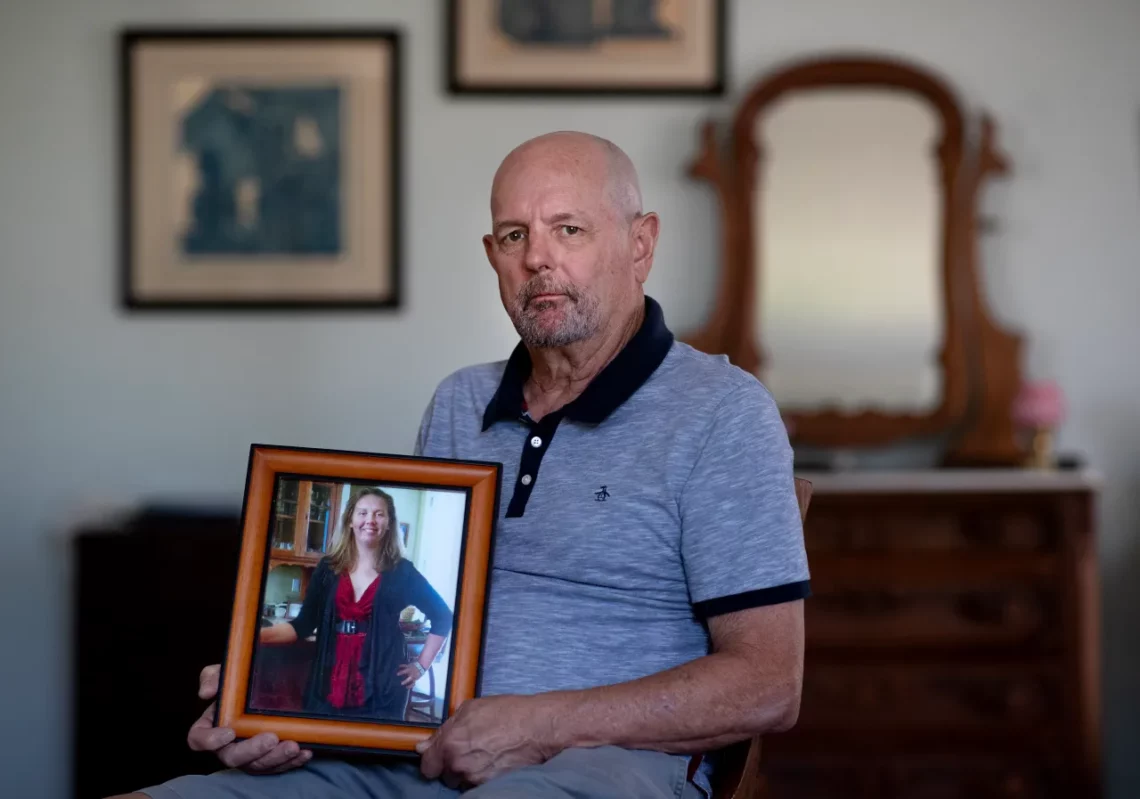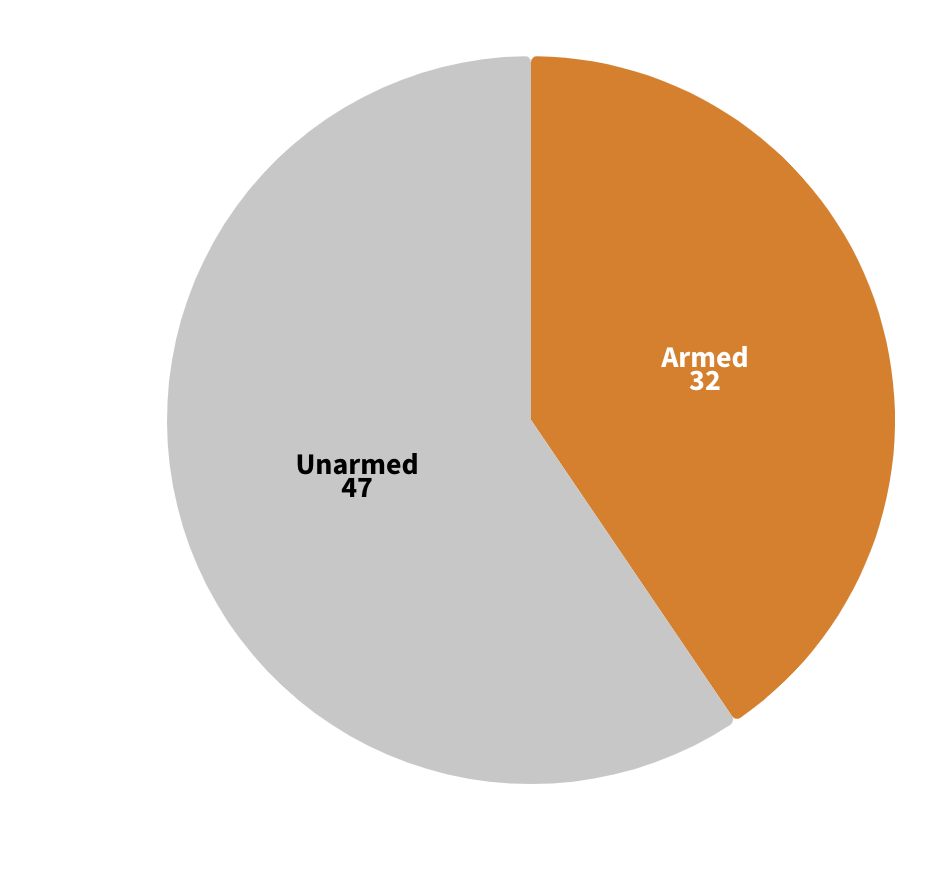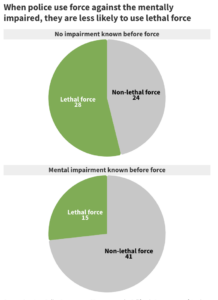Losing control: When San Jose police confront people in mental health crisis, why do they end up hurting them so often?
A first-of-its-kind investigation finds that huge proportions of the people officers beat, tase, shoot and kill are mentally ill or intoxicated
By ROBERT SALONGA | rsalonga@bayareanewsgroup.com, HARRIET BLAIR ROWAN | hrowan@bayareanewsgroup.com and LISA PICKOFF-WHITE, KQED | This story was originally published by The San Jose Mercury News on October 8, 2023. Pictured above: In this still from an officer’s body camera video, Thompson Nguyen walks through a South San Jose power plant, carrying a metal pipe and an ax and yelling, “Shoot me.” Police considered using non-lethal force to subdue him, but as Nguyen neared the officers, they fatally shot him instead. (San Jose Police)
The second time, police killed him.
Tensions ran high on an evening in January 2018, as police responded to urgent calls of an armed man menacing a San Jose power plant. Nguyen’s behavior – failing to respond to commands, beseeching cops to “shoot me, kill me” – alerted the officers to his brittle condition, but they could not calm him and never attempted non-lethal force during the eight-minute encounter.
Instead, as Nguyen strode toward them, an ax and metal pipe in his hands, two officers fired their guns a total of five times. One of them later told investigators he believed Nguyen was bent on “suicide by cop.” If so, he succeeded.
“I knew that if I’m not there and the cops are involved, he’s going to die,” said Nguyen’s brother, Tony Chi, in a recent interview. “And that’s what happened.”
Nguyen’s death exemplifies a tragic, troubling reality for law enforcement in San Jose: Huge proportions of the people officers beat, tase, shoot and kill are mentally ill or intoxicated from drugs or alcohol. In crisis, unable to control themselves, these individuals often can’t form the malevolent intent we associate with dangerous criminals.
Realizing the challenge, the San Jose Police Department has committed considerable effort to teaching its officers to handle these situations, becoming a national leader when it required all of its officers to undergo specialized crisis intervention training beginning in 2017.
Yet in the heat of the moment, many of San Jose’s officers can still find no other way to resolve such interactions but with violence.
A first-of-its-kind investigative analysis of San Jose police records between 2014 and 2021 found that:
- An overwhelming majority of those seriously injured by police in San Jose are mentally impaired. Of the 108 individuals on whom San Jose officers used batons, Tasers or guns to cause what’s legally known as “great bodily injury,” nearly three-quarters were believed to be mentally ill or intoxicated.
- The proportion of the mentally impaired among those killed by police is even higher. Eighty percent – 20 of 25 – of the victims of fatal incidents were classified as mentally ill or intoxicated.
- Extensive officer education has failed to curb the trends. In fact, since San Jose began its training effort, the percentage of serious force incidents that involved the mentally impaired has slightly increased. This is true even though police now recognize signs of mental illness or intoxication the vast majority of the time.
- A review of cases involving the mentally impaired raises questions about why force was the end result in many of them. In about a quarter of the confrontations, officers initiated contact with the subjects on their own, often over relatively minor infractions. Other times, police spotted or were called to help someone acting erratically, and the incident spiraled out of control. In well under half was the person armed

To reach these conclusions, journalists for the Bay Area News Group and the California Reporting Project, working with students from Stanford University and UC Berkeley, reviewed thousands of pages of police records released under California transparency laws and the terms of a 2020 settlement of the news group’s lawsuit against the city of San Jose.
The incidents examined involved dozens of San Jose officers, suggesting the approach to using force is common practice within the department, rather than the work of poorly trained or rogue officers.
The numbers convey a host of problems beyond the scope of law enforcement – from the prevalence of substance abuse to the woeful lack of treatment options for the mentally ill and the addicted.
But they also raise two questions that San Jose police have tried – and so far failed – to resolve: Why, so often, do police end up confronting individuals who so clearly need something other than a law enforcement response? And why can’t they stop hurting them?
“The obvious answer is that the training doesn’t work,” said Tom Nolan, a retired Boston police lieutenant who is now a criminal justice professor. “Law enforcement has always been ill-equipped in dealing with people in crisis. We have to change the mindset that police are all things to all people, and reimagine their role, and what we expect from the police.”
The challenge is vast. According to the department’s data, the number of “5150” calls police shorthand for cases involving mental health crises rose from 2,531 in 2014 to 3,537 in 2021, a 40% increase. Many of those calls are resolved without a police response; when police do respond, a large percentage are handled without confrontation.
Still, as police themselves emphasize, interactions with troubled subjects are unfailingly challenging, demanding sensitivity and skills most of us don’t naturally possess.
“Nothing is more unpredictable than human behavior, and then you add in mental illness or severe substance abuse, and you’ve made that difficult equation that much more difficult and unpredictable,” said San Jose Police Assistant Chief Paul Joseph, whom the department designated as its spokesperson to respond to this news organization’s investigation. “Any technique or tactic we ever use is not a guarantee of any particular outcome. The other person in the situation has something to do with the outcome, probably far more than we do.”
More training, but the problems continue
Beginning in 2017, the San Jose Police Department set out to better handle these encounters, becoming the first big-city department in the United States to mandate crisis intervention training for all its officers – a move propelled in part by the case of a young, mentally ill woman named Diana Showman.
On August 14, 2014, Showman called 911 during a psychiatric breakdown and told dispatchers she was going to shoot her family with an “Uzi.” The episode ended with the 19-year-old, who was holding a cordless drill spray-painted black, shot dead by police outside her family’s Blossom Hill Road home.

Jim Showman became a strong advocate for police mental health training after his daughter Diana was shot dead by police in 2014 as she brandished a drill painted black. He is showing a picture taken on her 19th birthday, one day before her death.(Karl Mondon/Bay Area News Group)
Her father, Jim Showman, remains haunted by how officers closest to Diana, who would have had the clearest view of her makeshift “weapon,” held their fire. It was an officer farther away who delivered the fatal bullets, according to a review of police reports — though those reports give no indication of whether the officers positioned closer believed Diana posed a threat. Body cameras were not in use at the time.
“If they thought that was a real Uzi, she would have been peppered with bullets, and they didn’t fire,” Showman said in a recent interview.
In the aftermath, Showman advocated for the Crisis Intervention Team training. In fact, such training was a condition of his family’s legal settlement with the city, although Showman says he’s been disappointed with the results.
“I thought it would give them more of a clinical education in dealing with mental health and people in crisis, that they would back off and acknowledge and recognize that this is not a normal event, that this is a person who is having some type of an issue,” Showman said. “It didn’t seem like that occurred.”
The mentally impaired — more often than not — do not pose a deadly threat

Source: San Jose Police Department SB 1421 records, California Department of Justice Use of Force Incident Reporting, Santa Clara County Superior Court records, 2014 – 2021 • Analysis by Harriet Blair Rowan and Lisa Pickoff-White.
CIT training teaches officers to recognize signs of mental illness and drug or alcohol intoxication — and San Jose police have become adept at doing that. Prior to 2017, records show, police were told or were able to identify whether someone was mentally impaired in 58% of force cases involving people in crisis; since then, the proportion is 77%.
Police receive a minimum of 40 hours of training, and additional ongoing instruction, to avoid violent confrontation by using de-escalation practices, which SJPD policy describes as staying calm in the midst of conflict, deflecting verbal abuse, and offering empathy. Training materials instruct officers to “recognize that an arrest may not be the only objective” and emphasize that they should not rush a confrontation to a conclusion, listening 80% of the time to “understand not respond.”
Joseph insists the training has been effective, especially in the face of the substantial increase in 5150 calls. He said the department’s own analysis indicates that instances where officers used force in responding to those calls dropped by half from 52 in 2015 – the first year SJPD tracked this specific data point – to 26 in 2021. That analysis — conducted following inquiries from this news organization — was the first such study San Jose police had done of their own response patterns to cases involving people in crisis.

San Jose Police Assistant Chief Paul Joseph contends that the department’s mandated crisis-intervention training is working to limit violent encounters, in the face of a substantial increase in mental health calls in recent years. (Karl Mondon/Bay Area News Group)
“That absolutely shows we have been using force in less cases,” Joseph said, adding that “the outcomes of these situations are not entirely within our control. The fact that force is used in a situation does not indicate a failure to properly de-escalate.”
However, the figures Joseph cites are limited to instances in which police were called specifically to respond to a person suffering a mental crisis – cases, in other words, where police knew what they were getting into. They do not include situations where police themselves initiated contact with a person whom they presumed to be mentally ill or intoxicated, or where the person’s mental state was not known until after police arrived at the scene.
By contrast, the analysis performed by the Bay Area News Group and the California Reporting Project considers the full range of confrontations between police and the mentally ill. But it is limited to those resulting in significant injury or death – the only cases whose release is required by law. Police are allowed but not required to release cases in which they deem their use of force to have caused minor or no injuries, and San Jose in general does not release them.
Looking at the publicly released serious-injury cases, about 67% of San Jose’s force incidents involved the mentally ill or intoxicated prior to 2017, rising to about 77% since then. While the totals vary year to year, there is no indication the violent confrontations are trending downward, despite the training efforts.
As with most large police departments in California, the people hurt or killed by police in San Jose are disproportionately Latino and Black, compared to the city’s overall population. Of the 108 people seriously injured by police between 2014 and 2021, 59 were identified as Hispanic, 27 were White, 10 were Black, and nine were Asian. Race was not identified in three of the cases.
Overall, of those 108 individuals, mentally ill and intoxicated people accounted for 72% of those against whom an officer used a gun. They accounted for 71% of physical strikes using hands, elbows or feet, 71% of baton strikes, 91% of the use of beanbag projectiles, and 95% of Taser deployments.

Source: San Jose Police Department SB 1421 records, California Department of Justice Use of Force Incident Reporting, Santa Clara County Superior Court records, 2014 – 2021 • Analysis by Harriet Blair Rowan and Lisa Pickoff-White
The case files show that many of the incidents that end in severe injury start with behavior so innocuous it begs the question of why there was a confrontation at all. Three violent incidents came after people were stopped for not having a bicycle headlight. Two began with suspected public intoxication. One man was injured by two police officers after shining a flashlight in their direction.
A total of 19 force cases involving the mentally ill or intoxicated began with officers confronting subjects by their own choice, rather than investigating a crime or responding to a call for help. In the majority of cases involving the mentally ill or intoxicated – 59% – the people injured by police were not armed.
Yet in the cases reviewed, no officer has been disciplined for using force against someone who was mentally impaired.
Seth Stoughton, a University of South Carolina law professor who was an expert prosecution witness in the seminal trial over the 2020 death of George Floyd at the hands of Minneapolis police officers, called the trends concerning.
Generally, Stoughton said, “individuals with mental illness are not dangerous. They do not commit crimes in a way that is particularly worrisome. … It’s not a crime to act erratically.”

Source: San Jose Police Department SB 1421 records, California Department of Justice Use of Force Incident Reporting, Santa Clara County Superior Court records, 2014 – 2021 • Analysis by Harriet Blair Rowan and Lisa Pickoff-White.
‘This guy’s about to get batoned’
The 2019 beating of Arthur Lee Turner tells a critical story behind the numbers: For mentally impaired people, there is often only a thin line between a routine interaction with the police – and violence.
Turner’s trouble began when two San Jose officers conducting a community foot patrol came upon a group of unhoused people at an encampment in the city’s Guadalupe River Park and Gardens, and decided to clear the site. (At least a dozen of SJPD’s force incidents over the last decade involve unhoused people, although those numbers are likely undercounted because police are not regularly documenting housing status.)
Body camera video of the November 2019 encounter shows officers Alex Cristancho and Steven Aponte announcing to the group that they were “detained,” and ordering them to stay where they were. When Turner started to walk away, the officers almost immediately decided to use force to subdue him — though Turner was unarmed and did not appear to threaten the officers throughout the incident.
Video: “Watch this guys.”
SETTING THE SCENE: Two San Jose police officers encounter Arthur Lee Turner, a resident of a homeless encampment who proclaims himself to be God and will not follow their commands.
WHAT TO WATCH FOR: One of the officers announces to the other encampment residents, “Watch this guys, this guy’s about to get batoned.” Although Turner does not appear to threaten them, they also tase and pepper-spray him.
THE OUTCOME: Turner suffers a broken hand and multiple lacerations to his face. He is arrested for resisting arrest, assaulting an officer, and providing a false identity.
“Watch this guys, this guy’s about to get batoned,” one officer can be heard telling the other people who had been detained. Within minutes, the officers had shot Turner with a taser, hit him with their batons and used pepper spray.
Falling to the ground, Turner proclaimed himself to be “God,” warning officers not to “mess with God.” As officers climbed on top of him to handcuff him, Turner struggled, asking the officers to “please take your knee off me so I can breathe.”
Medical personnel were called, and Turner was treated for two broken fingers and lacerations to his face and neck and taken to jail. An internal review raised no questions about the officers’ use of force.

But Nolan, who reviewed video of Turner’s arrest, said it was the officers who laid the groundwork for what unfolded.
“I didn’t see (Turner) commit any crimes other than defending himself after being beaten with a weapon,” he said. “What we saw on this video is the wrong approach.’’
Walter Katz, who served as San Jose’s independent police auditor at the time the department rolled out its mandatory crisis intervention training, agreed, calling the use of force in the Turner case “avoidable from the very beginning.”
“You roll into the scene and tell everyone, ‘You’re all detained,’ what are you expecting is going to happen? You just showed up as a disruptor,” Katz said. “If their goal is to clear the encampment, I have no idea what their plan was.”
Joseph declined to comment specifically on the Turner case, but said the department empowers officers to walk away from calls that don’t involve a serious crime.
“There is always going to be a judgment made on, is it worth potentially becoming involved in a serious violent encounter in order to make an arrest?” he said. “We do still have a job to do, we do still have an obligation to protect public safety and enforce the law.”
‘I just want to leave’
The May 26, 2021, violent arrest of William Wallace raises similar questions about why police chose to confront someone they immediately concluded was mentally impaired. As officer Barron Kim described it, Wallace’s infraction was minor: He had jaywalked with his bicycle in an empty Sunol Street near the intersection with West San Carlos Street.
Kim ordered Wallace to stop, but Wallace walked away erratically instead. According to police reports and body-worn camera footage, Kim then grabbed Wallace, who responded by uttering threats, pushing his bike at the officer, and at one point reportedly throwing a punch. Kim chased Wallace and subdued him with a series of hand and baton strikes, as Wallace moaned “I just want to leave.” Wallace, who was found to have “glass narcotics pipes” in his pocket, suffered a broken nose in the encounter.
Video: “You’re not free to leave.”
SETTING THE SCENE: Officer Barron Kim confronted William Wallace after seeing him jaywalk with his bike across an empty street.
WHAT TO WATCH FOR: Wallace resists Kim’s order to stop, but appears to pose no threat until Kim accosts him. Should Kim have simply let him go?
[Video link through San Jose Mercury]
THE OUTCOME: After Wallace filed a complaint, San Jose’s Independent Police Auditor raised questions about why Kim felt it necessary to engage and then beat Wallace. The department exonerated Kim.
When Wallace later complained to the department about the beating, San Jose’s independent police auditor – upon reviewing the records – raised pointed questions about why Kim confronted Wallace at all, and why he decided to use force. The department’s Internal Affairs unit reviewed the incident and interviewed Kim, but eventually exonerated him.
In a written statement to this news organization, the police department emphasized the larger threat Wallace posed, noting that he had a violent criminal history and was suspected of other crimes including identity theft — “factors that are likely to result in a police contact even if the officer had not come upon him.”

But nowhere in the officer’s report is it stated that he knew about Wallace’s criminal history before or during the roadway stop.
Was Wallace’s initial behavior cause for confrontation? Did Kim – who initially was alone, without backup – have a better choice once Wallace resisted his order to halt?
Sandra Hernandez, director of the Santa Clara County Behavioral Health Division, said sometimes police must consider the potential wisdom of walking away.
“It’s counterintuitive to what we used to think, where if someone is doing something wrong, we arrest them,” she said. “But we have to ask: Are they hurting somebody? What’s the goal here?”
A better choice?
To be sure, there are times when San Jose police seem to use their crisis training appropriately, avoiding violence.
In response to a request from this news organization, the department allowed reporters to review two cases in which officers resolved high-risk encounters without force: A 2017 case involving a man attempting to steal power tools and machetes from a Home Depot; and a 2018 case in which police were called to a report of a “mentally disturbed” person walking into traffic. The department stipulated that no one involved in these two cases be identified.
In both cases, officers were told beforehand that they were encountering someone in crisis, and were able to prepare. The Home Depot incident in particular shows the benefits of trustworthy information: The report came from an officer working after hours as a security guard in the store.
Understanding the suspect might act unpredictably, police evacuated the store and deployed carefully at its entrances. The suspect attempted to flee through several different doors, only to be met by officers, prompting him to run back inside.
Eventually, the man dropped his backpack, took off his shirt, and got “in a fighter stance,” according to police records. Soon, the man was facing six officers and raised his arms wide, yelling, “If you’re going to shoot me, shoot me.”
Some officers readied their Tasers and another drew his baton. But an officer who took on the role of crisis negotiator continued his efforts to calm the man, promising to call an ambulance to care for him and urging him to show his hands, which the suspect had kept behind his back.
Finally, suddenly, the tension broke. The man complied, and was arrested without resistance.
Less lethal force
Nowhere is the scrutiny of police behavior greater than when confrontation leads to death. Over the past decade, San Jose police – like many of their counterparts around the country – have engaged in concerted efforts to avoid the use of lethal force, training officers relentlessly and supplying many more nonlethal weapons, from foam bullets to beanbag launchers to tasers.
Broadly, the news organization’s analysis shows, these efforts seem to have reduced the tendency for police to resort to gunfire. There has been a steady decline in use of lethal force against all subjects since 2018, from 43% of serious-injury cases that year, to 33% in 2019, 31% in 2020 and 20% in 2021.
But that decrease has come in roughly equal proportion with those who are mentally impaired and those who are not. In fact, the proportion of the mentally ill and intoxicated among those killed by San Jose police remains stubbornly – even shockingly – high: 20 of 25 from 2014 to 2021, 12 of 14 beginning in 2017.
Stoughton said it can be difficult to draw significant conclusions from a relatively small number of cases. But he was struck by the 80% proportion of police deaths that involved mentally ill or intoxicated people.
“That’s a high number. When we look nationally at mentally ill individuals killed by police, it’s somewhere between about 25% to 40%,” he said.
The percentages Stoughton cites do not include subjects intoxicated with alcohol or drugs. For comparison, in San Jose, 52% of those killed in encounters with police were thought to be mentally ill, according to the news organizations’ analysis.
Suicidal and grievously wounded by his own hand, Anthony Nunez died on the Fourth of July in 2016 when officers called to respond to the crisis opened fire because Nunez “twirled” the revolver with which he had shot himself. A DA’s review cleared the officers, but a federal jury agreed with Nunez’s family that he posed no threat and awarded $2.6 million.
Three years later, Francis Calonge perished on Halloween day from a single gunshot wound as he walked away from officers with a visible weapon that turned out to be a BB pistol in his waistband. Police said they worried he was heading toward Independence High School, which was several blocks away. Later investigation established Calonge had a history of mental illness and was high on methamphetamine at the time of the incident.
In some of the fatality cases, it is easy enough to see – in the heat of the moment – why police resorted to lethal force. But in others, the tragedies leave behind survivors who look at the series of choices leading up to fatal confrontations and wonder, as Thompson Nguyen’s family does, whether a different course of action would have prevented their deaths.
‘We don’t expect a death sentence’

Tony Chi talks about his late brother, Thompson “Tommy” Nguyen, Saturday, March 25, 2023, at the familyÕs home in San Jose. Tommy Nguyen was shot by San Jose police in 2018 during an encounter at a South Bay power plant in which he carried an ax while suffering a psychiatric crisis. (Karl Mondon/Bay Area News Group)
Five years after Nguyen’s deadly encounter with police, Tony Chi still has clear memories of how he and his family tried to get help for his younger brother as he began to descend into a spiral of delusions.
A brief hospitalization in the emergency psychiatric unit didn’t help, and Nguyen resisted attempts at group and individual therapy. When his desperate family called 911 in November of 2017 after a frantic Nguyen locked himself in his room, responding officers said all they could do was break into the room and subdue him, Chi recalls. Chi imagined the break-in going terribly wrong, and sent the officers away.
Just two months later, on Jan. 9, 2018, Nguyen’s psychotic break led him to Metcalf Energy Center in South San Jose, where he began walking the grounds while holding an ax and metal pipe. Anxious staff at the plant called the police and evacuated as four officers responded.
Bodycam video indicates Nguyen never raised his arms or overtly menaced police with the weapons he held, but he repeatedly failed to heed their commands to drop his weapons and would not halt his advance toward them.
Video: “Shoot me!”
SETTING THE SCENE: San Jose police responded to a report of an armed man breaking into a power plant, and encountered Thompson Nguyen carrying a metal pipe and an ax.
WHAT TO WATCH FOR: As Nguyen approaches police, exclaiming “shoot me,” one officer calls to tase him but the others fire their guns instead
THE OUTCOME:
A district attorney’s review clears the officers, saying Nguyen “had decided he was going to die that day.” Although a district attorney’s review cleared the officers of any misconduct, questions remain why they didn’t attempt nonlethal force to corral him – particularly since at one point early in the sequence, officers unsuccessfully sought to have a 40 mm non-lethal launcher delivered to the sceneThe video shows what appears to be a fatal miscommunication in the final moments of the confrontation, as one officer, Timothy Faye, yells “Tase him!” immediately before another officer shoots Nguyen instead.
“It’s a very tragic shooting,” Katz said. “It’s not one I’m necessarily comfortable saying was avoidable. One would hope that the department really dissects and tries to learn lessons on what it could possibly do differently.”
Five years later, the Nguyen family is still searching for answers about what else they could have done — and who else, besides the police, they could have turned to for help.
“They need to recognize that he’s not there to hurt anyone,” Chi said. “When we call, we don’t expect a death sentence. We’re calling for help. Now I don’t feel like I will ever call the police.”

If you or someone you know is struggling with feelings of depression or suicidal thoughts, the 988 Suicide & Crisis Lifeline offers free, round-the-clock support, information and resources for help. Call or text the lifeline at 988, or see the 988lifeline.org website, where chat is available.
Credits
This story was produced with reporting from Stanford University: Leila Barghouty, Mez Belo-Osagie, Irene Casado Sánchez, Sophia Chen, Kavish Harjai, Justin Hogg, Yoni Lerner, Galen Lew, Kyle McKinley, Arturo Mendoza, Dilcia Mercedes, Melissa Newcomb, Camryn Pak and Syler Peralta-Ramos, Sonya Schoenberger; from Berkeley Journalism’s Investigative Reporting Program: Nazmul Ahasan, Bella Arnold, Irene Bendicto, Hanisha Harjani, Katherine Li, Grace Marion, Matthew Miranda, Eliza Partika, Lesley Torres, Krissy Waite, Junyao Yang and Brittany Zendejas; and from The California Newsroom, a collaboration of public media newsrooms: Lezla Gooden and Molly Peterson. The California Reporting Project collected police records. The Starling Lab for Data Integrity at Stanford University and the University of Southern California supported this work.












